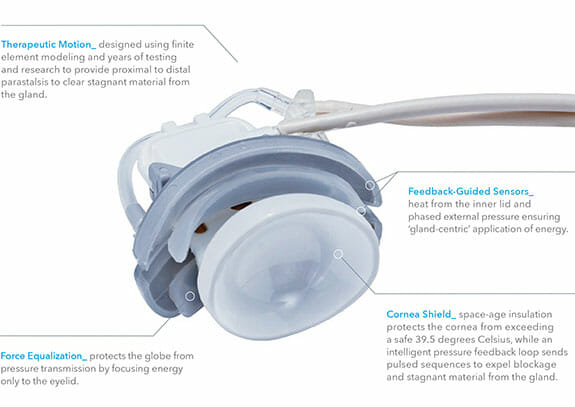
What is Dry Eye?
Dry Eye is a disease that occurs when the eye does not produce tears with appropriate quality, quantity or both. Dry Eye disease causes more than just discomfort; it can result in permanent damage to the cornea and eyelids, vision loss and other problems. While every aspect of dry eye is not completely understood, we do know that underlying inflammation is often the cause. Dry Eye disease can make it more difficult to perform some activities, such as using a computer or reading for an extended period of time.
How do we diagnose dry eye disease?
A series of assessments is utilized to determine if you have dry eye disease and the underlying causes. With this vital information, we can categorize the nature of dry eye disease you have, enabling us to create a customized treatment plan specific to your diagnosis.
Testing may include:
- An extensive patient history with a focus on overall health, medications, environmental factors and family history.
- A detailed external examination of the eye, including the cornea, lid structure and blink dynamics.
- Specific measurements of the quantity and quality of tears.
- We will use cutting edge technology to assess your eyes as thoroughly as possible.
Warning signs of dry eye?
- stinging or burning of the eye
- sandy or gritty feeling as if something is in the eye
- episodes of excess tearing
- stringy or mucous discharge from the eye
- pain and redness of the eye
- blurred vision
- eye fatigue
- dry feeling in the eye
- heavy eyelids
- sensitivity to light
- uncomfortable contact lenses
Dry Eye or MGD?
Understanding Meibomian Gland Disease (MGD)
For over 60 years, the term “Dry Eye” has been generally applied to a variety of uncomfortable eye surface problems, much in the same way the term back pain is generally used. The eye feels uncomfortable, but the cause is unknown. Dry eye symptoms have primarily been thought to be a direct result of the eye’s inability to produce the proper amount of natural tears, but we now know that is not the case for many dry eye sufferers.
Today, the leading cause of dry eye is known to be Meibomian Gland Disease (MGD) for over 86% of patients who present with symptoms, such as discomfort, redness, tearing, gritty or burning sensations and blurry vision. While MGD is chronic and progressive, if caught early, it can be effectively treated to stop the progression and maintain optimal eye health.

LIPIFLOW
LIPIFLOW® – FDA CLEARED AND PROVEN TO BE EFFECTIVE IN CLINICAL STUDIES
LipiFlow uses vectored thermal pulsating eyepieces known as Activators. LipiFlow Activators are precisely designed to provide necessary inner and outer lid contact to properly apply heat and massage and evacuate the meibomian glands. The entire treatment takes approximately 12 minutes.
The clinical science behind MGD as the primary cause of dry eye and its treatment is supported by over 25 years of scientific research. Removal of the gland blockages is essential to improve gland function and reduce the progression of MGD. Over time after treatment, the meibomian glands may become blocked again because of continued evaporative stress, which is caused by infrequent blinking from modern lifestyles and leads to thickening of the gland secretions and blockage of oil production.
LipiFlow treatment
LipiFlow is a 12 minute treatment that is the only FDA cleared treatment using thermal pulsating heat to remove blockages in the Meibomian glands. When the Vectored Thermal Pulse (VTPTM) LipiFlow treatment is properly applied, the heat and gentle massaging action evacuate the blockages from the glands, allowing the glands to resume oil production. You and your eye care professional can determine how often LipiFlow should be repeated based on evaluation of your gland function and structure over time.
